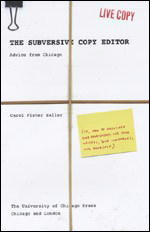Copy editing and the fine art of chilling out
 From this month’s Chicago Style Q&A:
From this month’s Chicago Style Q&A:
Q. “The first of which is better.” I said this is a sentence fragment, but a student pointed out that it has a subject and predicate. Who’s correct?
A. You both are. A sentence fragment can have a subject and predicate, but it’s a fragment if it’s dependent on another clause. Your fragment can’t stand alone grammatically; it needs a main clause to lean on: “The choice is between a hamantash and a latke, the first of which is better.”
Thus, with an emphasis on negotiation and flexibility, Carol Fisher Saller, assistant managing editor at the University of Chicago Press and the unfailing wit behind the Chicago Manual of Style Q&A, has established herself as a subversive exception to the stereotype of the manuscript-editor-as-quibbler. And now, as Jennifer Balderama has noted in a recent appreciation for the New York Time‘s Paper Cuts blog, with her newly released book The Subversive Copy Editor: Advice from Chicago (or, How to Negotiate Good Relationships with Your Writers, Your Colleagues, and Yourself) Saller takes the next big step in advancing her mission to revolutionize the way people think about the dialectic of manuscript editing. From the Paper Cuts blog:
This is a “relationship” book, writes its author, Carol Fisher Saller, doyenne of The Chicago Manual of Style Online‘s Q&A. Here, she hopes to “soothe and encourage and lend power” to editors who have too long suffered “from the oppression of unhelpful habits and attitudes.” This is the book Oprah would write if her vocation were saving writers from embarrassment, rather than saving the whole world.
To which I say: finally. I’ve got dozens of books concerned with the nuts and bolts of copy-editing, but this is the only one that teaches the fine art of chilling out.… Saller’s project, in about 100 pages, is to (a) civilize the editing process, and (b) keep copy editors—meticulous and learned and hard-working, but also stubborn and obsessive, sometimes injuriously so…—from going insane. She reminds us that the reader is Priority 1 and that while standards are crucial (“I’m not going to suggest that you toss out your stylebook”), so is flexibility (sometimes “a style is just a style”).
Continue reading the posting on the NYT‘s Paper Cuts blog, or read the introduction to the book.
The author has also created her own website, check it out at www.subversivecopyeditor.com.